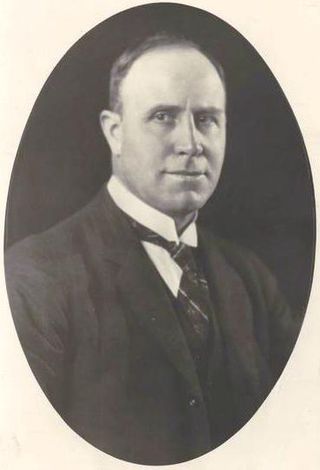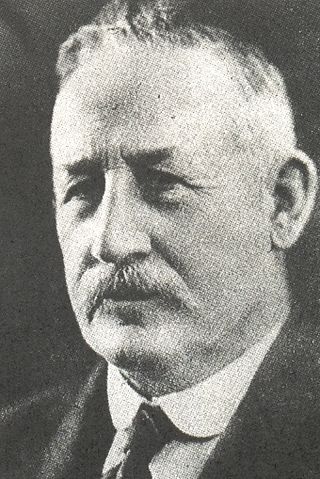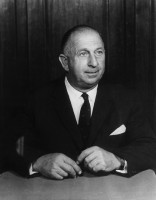
Sir Alexander James Peacock was an Australian politician who served as the 20th Premier of Victoria.

Sir Harry Sutherland Wightman Lawson KCMG, was an Australian politician who served as Premier of Victoria from 1918 to 1924. He later entered federal politics, serving as a Senator for Victoria from 1929 to 1935, and was briefly a minister in the Lyons government. He was a member of the Nationalist Party until 1931, when it was subsumed into the United Australia Party.

John Allan was an Australian politician who served as the 29th Premier of Victoria. He was born near Lancefield, where his father was a farmer of Scottish origin, and educated at state schools. He took up wheat and dairy farming at Wyuna and was director of a butter factory at Kyabram. In 1892 he married Annie Stewart, with whom he had six children.

Sir Albert Arthur Dunstan, KCMG was an Australian politician who served as the 33rd premier of Victoria from 1935 to 1943 and from 1943 to 1945 and as the third deputy premier of Victoria for five days in March 1935. A member of the Country Party, now the National Party, his term as premier was the second-longest in the state's history and the longest of any third-party premier. He was the first person to hold the office of premier in its own right, and not an additional duty taken up by the Treasurer, Attorney-General or Chief Secretary.

The Treasurer of Victoria is the title held by the Cabinet Minister who is responsible for the financial management of the budget sector in the Australian state of Victoria. This primarily includes:

Elections were held in the Australian state of Victoria on 15 July 1961 to elect the 66 members of the state's Legislative Assembly and 17 members of the 34-member Legislative Council. MLAs were elected for three year terms and MLCs were elected for six year terms. All were elected in single-member districts or provinces using preferential voting.

The Attorney-General of Victoria, in formal contexts also Attorney-General or Attorney General for Victoria, is a minister in the Government of Victoria, Australia. The Attorney-General is a senior minister in the state government and the First Law Officer of the State.
The Allan Ministry was the 44th ministry of the Government of Victoria. It was led by the Premier of Victoria, John Allan, and was formed by a coalition of the Country and Nationalist parties. The ministry was sworn in on 18 November 1924.
The Prendergast Ministry was the 43rd ministry of the Government of Victoria. It was led by the Premier of Victoria, George Prendergast, of the Labor Party. The ministry was sworn in on 18 July 1924. On 12 November 1924, a motion of no-confidence in the Prendergast government was proposed in the Legislative Assembly by John Allan, leader of the Country Party—the motion was carried 34 votes to 28, defeating the government. Allan and his ministry were sworn in on 18 November.

The 1917 Victorian state election was held in the Australian state of Victoria on Thursday 15 November 1917 for the state's Legislative Assembly. 51 of the 65 Legislative Assembly seats were contested.

The Kennett Ministry was the 64th ministry of the Government of Victoria. It was led by the Premier of Victoria, Jeff Kennett, of the Liberal Party. The ministry was sworn in on October 6, 1992, and remained a single ministry through two parliaments until on October 20, 1999.
The Cain II Ministry was the 62nd ministry of the Government of Victoria. It was led by the then Premier of Victoria, John Cain Jr., of the Australian Labor Party. The ministry was sworn in on April 8, 1982, and remained a single ministry through three parliaments until on August 10, 1990. The ministry dissolved upon Cain's resignation as Leader of the Labor Party.
The McPherson Ministry was the 46th ministry of the Government of Victoria. It was led by the Premier of Victoria, Sir William McPherson, and consisted of members of the Nationalist Party. The ministry was sworn in on 27 November 1928.
The Second Hogan Ministry was the 47th ministry of the Government of Victoria. It was led by the Premier of Victoria, Edmond Hogan, and consisted of members of the Labor Party. The ministry was sworn in on 12 December 1929.
The Argyle Ministry was the 48th ministry of the Government of Victoria. It was led by the Premier of Victoria, Stanley Argyle, and consisted of members of the United Australia Party (UAP) and the Country Party. The ministry was sworn in on 19 May 1932. On the 20th of March 1935, following the 1935 election, the Country party withdrew from the Coalition. Argyle then formed a new ministry of UAP members. The ministry was dissolved as a result of Argyle's resignation following defeat in the Legislative Assembly.

The Minister for Agriculture is a minister within the Executive Council of Victoria tasked with the responsibility of overseeing the Victorian Government's agriculture initiatives. The minister is supported by the Department of Energy, Environment and Climate Action's Agriculture Victoria.
The Liberal Party, often known simply as the Liberals, was the name used by a number of political groupings and parties in the Victorian Parliament from the late 19th century until around 1917.
The Second O'Shanassy Ministry was the 4th ministry of the Government of Victoria. It was led by the Premier of Victoria, John O’Shanassy, with the swearing in of the ministry occurring on 10 March 1858.
The Lawson Ministry was the 41st ministry of the Government of Victoria. It was led by the Premier of Victoria, Harry Lawson, and consisted of members of the Nationalist Party. The ministry was sworn in on 21 March 1918 following the resignation of John Bowser's short lived ministry. In September 1923 Lawson formed a coalition government with the Country Party. However, this coalition only lasted until March 1924, after which Lawson formed a minority Nationalist government. Shortly afterward in 1924, Lawson's government was defeated and succeeded by new Nationalist Leader Sir Alexander Peacock's government.
The Second Peacock Ministry was the 39th ministry of the Government of Victoria. It was led by the premier of Victoria, Alexander Peacock, and consisted of members of the Commonwealth Liberal Party, later known as the Nationalist Party. The ministry was sworn in on 18 June 1914 following the resignation of Premier William Watt to contest the 1914 federal election. The government was defeated at the 1917 state election by the anti-Peacock faction of the Nationalist party and succeeded by the Bowser ministry.







